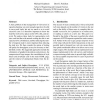Free Online Productivity Tools
i2Speak
i2Symbol
i2OCR
iTex2Img
iWeb2Print
iWeb2Shot
i2Type
iPdf2Split
iPdf2Merge
i2Bopomofo
i2Arabic
i2Style
i2Image
i2PDF
iLatex2Rtf
Sci2ools
SYSTOR
2010
ACM
2010
ACM
Empirical quantification of opportunities for content adaptation in web servers
A basic problem in the management of web servers is capacity planning: you want enough capacity to be able to serve peak loads, but not too much so as to avoid excessive costs. It is therefore important to know the load that web service places on the CPU, disk, and network. We analyze these loads for representative web sites, and find that with normal caching the disk is not expected to be a bottleneck, and that reducing the number of requests made is more important than reducing the total size. We then consider the option of trading off quality for throughput, as may be necessary to handle flash crowds. The suggested approaches include the elimination of graphical decorations and previews, the compression of large images, the consolidation of style sheets and JavaScript code in the main HTML page, and the removal of unimportant blocks from the design. Categories and Subject Descriptors C.5.5 [COMPUTER SYSTEM IMPLEMENTATION]: servers; H.3.2 [INFORMATION STORAGE AND RETRIEVAL]: Informa...
| Added | 06 Dec 2010 |
| Updated | 06 Dec 2010 |
| Type | Conference |
| Year | 2010 |
| Where | SYSTOR |
| Authors | Michael Gopshtein, Dror G. Feitelson |
Comments (0)

